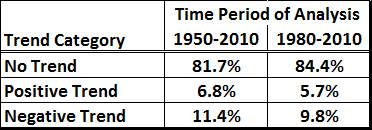| Tweet | Follow @co2science |
Paper Reviewed
Jiang, G., Liu, J., Xu, L., Yu, G., Honglin, H.E. and Zhang, Z. 2013. Climate warmng increases biodiversity of small rodents by favoring rare or less abundant species in a grassland ecosystem. Integrative Zoology 8: 162-174.
Climate model simulations generally predict a future with more frequent and more severe floods in response to CO2-induced global warming. Confirming such predictions with real world observations, however, has remained an elusive task. The latest study to illustrate this point comes from the four-member research team of Barros et al. (2014), who writing in the Journal of Hydrologic Engineering analyzed streamflow records at various locations throughout the southeast and mid-Atlantic United States over the past century.
In prefacing their work, the researchers note several challenges that exist that must be overcome in order to properly assess and attribute streamflow trends to anthropogenic climate change. One key challenge pertains to "the lack of long enough observational records [that are necessary] to capture the full range of time scales of variability in hydroclimatic regimes as well as extreme events." This is particularly true in the present case in which only about 3,000 of the 10,012 USGS streamflow gauges that exist within the authors' study region have data stretching beyond 25 years of record. In addition, there is often the added challenge of "intermittency in the spatial and temporal configuration of the observing system of stream gauges," as different stations both enter into, and exit out from, existence over the course of the study period and within the study region, thereby adding to the difficulty of assessing long-term trends.
Another factor that must be considered is changes in land-use and land cover (LULC) that can significantly influence streamflow. This is especially apparent in regions that have undergone significant urban development, which development creates impermeable surfaces and highly interconnected discharge networks that have been shown to contribute to what the authors refer to as "large flood peaks." Nevertheless, despite the aforementioned challenges, Barros et al. proceeded to conduct various statistical analyses on streamflow data from within their region of study at various time intervals over the past century.
Among their list of findings, the authors report "an overwhelming majority of stations shows no trend" in annual peak streamflow. Quantitatively, for the period 1950-2010, 81.7% of all stations examined in this 61-year period showed no trend at the 98% confidence level, 11.4% experienced a negative trend toward decreasing streamflow, and 6.8% showed a positive trend (Table 1). Similar trends were noticed over the shorter 31-year period between 1980 and 2010, albeit there is one important change that occurred, there were fewer percentages of stations experiencing negative or positive trends. Thus, rather than trending toward more extreme conditions, annual peak streamflow throughout the southeastern and mid-Atlantic USA over the past 30 years has become less extreme and more representative of average conditions. Moreover, those stations exhibiting positive trends tended to be found in urban areas (affected by LULC change), while those exhibiting negative trends tended to reside downstream of reservoirs (also a LULC factor).

In discussing their findings, Barros et al. say they "are consistent with Villarini and Smith (2010) in their analysis restricted to stream gauges with at least 75 years of record, with Hirsch (2011) using 200 stream gauges, and Vogel et al. (2011) and Lins and Cohn (2011) for the [Conterminous United States]." Given as much, it is extremely difficult to come to any conclusion other than the fact that the unanimous observations depicted in these studies do not support model-based claims that CO2-induced climate change is leading to more floods. In contrast, if anything, just the opposite appears to be the case as annual peak streamflow has trended more toward average conditions.
References
Barros, A.P., Duan, Y., Brun, J. and Medina Jr., M.A. 2014. Flood nonstationarity in the southeast and mid-Atlantic regions of the United States. Journal of Hydrologic Engineering 19, 05014014. DOI: 10.1061/(ASCE)HE.1943-5584.0000955.
Hirsch, R. M. 2011. A perspective on nonstationarity and water management. Journal of the American Water Resources Association 47: 436-446.
Lins, H. F. and Cohn, T. A. 2011. Stationarity: Wanted dead or alive? Journal of the American Water Resources Association 47: 475-480.
Villarini, G. and Smith, J. A. 2010. Flood peak distributions for the eastern United States. Water Resources Research 46: W06504.
Vogel, R. M., Yaindl, C. and Walter, M. 2011. Nonstationarity: Flood magnification and recurrence reduction factors in the United States. Journal of the American Water Resources Association 47: 464-474.
Posted 21 November 2014



